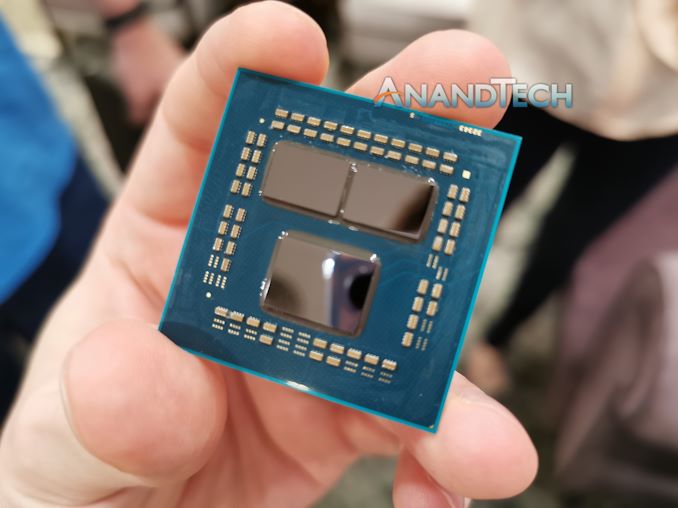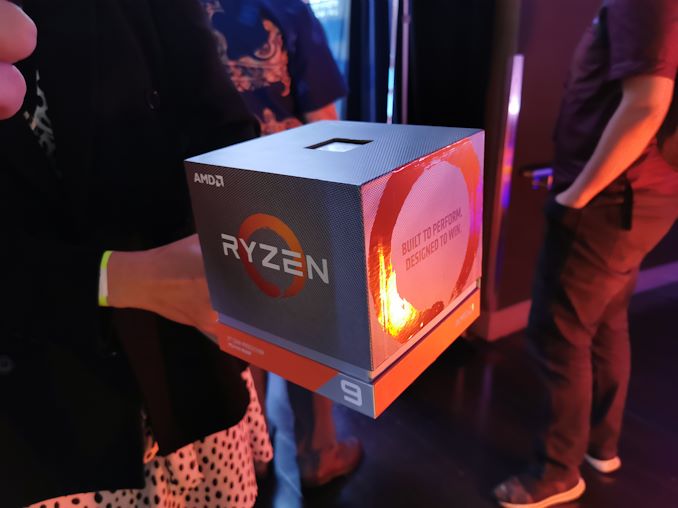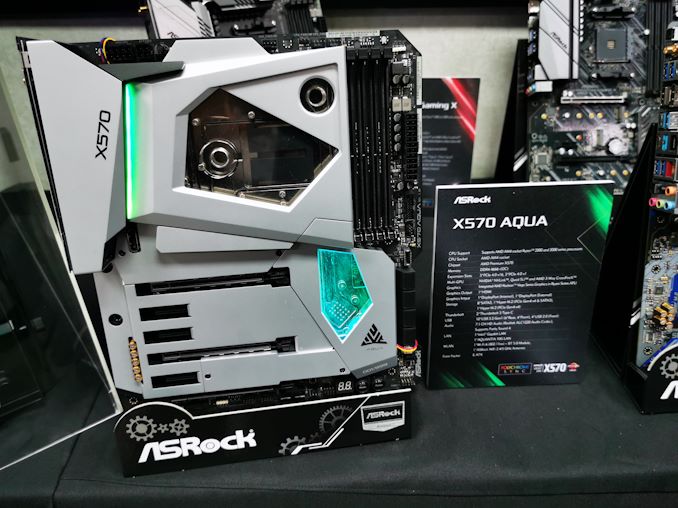AMD 16-Core Ryzen 9 3950X: Up to 4.7 GHz, 105W, Coming September
by Dr. Ian Cutress on June 11, 2019 6:00 PM EST- Posted in
- CPUs
- AMD
- Ryzen
- Zen 2
- Ryzen 3000
- Ryzen 3rd Gen
- Ryzen 9
- 3950X

One of the questions that was left over from AMD’s Computex reveal of the new Ryzen 3000 family was why a 16-core version of the dual-chiplet Matisse design was not announced. Today, AMD is announcing its first 16 core CPU into the Ryzen 9 family. AMD stated that they’re not interested in the back and forth with its competition about slowly moving the leading edge in consumer computing – they want to launch the best they have to offer as soon as possible, and the 16-core is part of that strategy.
The new Ryzen 9 3950X will top the stack of new Zen 2 based AMD consumer processors, and is built for the AM4 socket along with the range of X570 motherboards. It will have 16 cores with simultaneous multi-threading, enabling 32 threads, with a base frequency of 3.5 GHz and a turbo frequency of 4.7 GHz. All of this will be provided in a 105W TDP.
| AMD 'Matisse' Ryzen 3000 Series CPUs | |||||||||||
| AnandTech | Cores Threads |
Base Freq |
Boost Freq |
L2 Cache |
L3 Cache |
PCIe 4.0 |
DDR4 | TDP | Price (SEP) |
||
| Ryzen 9 | 3950X | 16C | 32T | 3.5 | 4.7 | 8 MB | 64 MB | 16+4+4 | ? | 105W | $749 |
| Ryzen 9 | 3900X | 12C | 24T | 3.8 | 4.6 | 6 MB | 64 MB | 16+4+4 | ? | 105W | $499 |
| Ryzen 7 | 3800X | 8C | 16T | 3.9 | 4.5 | 4 MB | 32 MB | 16+4+4 | ? | 105W | $399 |
| Ryzen 7 | 3700X | 8C | 16T | 3.6 | 4.4 | 4 MB | 32 MB | 16+4+4 | ? | 65W | $329 |
| Ryzen 5 | 3600X | 6C | 12T | 3.8 | 4.4 | 3 MB | 32 MB | 16+4+4 | ? | 95W | $249 |
| Ryzen 5 | 3600 | 6C | 12T | 3.6 | 4.2 | 3 MB | 32 MB | 16+4+4 | ? | 65W | $199 |
AMD has said that the processor will be coming in September 2019, about two months after the initial Ryzen 3rd Gen processors, due to extra validation requirements. The chip uses two of the Zen 2 eight-core chiplets, paired with an IO die that provides 24 total PCIe 4.0 lanes. By using the AM4 socket, AMD recommends pairing the Ryzen 9 3950X with one of the new X570 motherboards launched at Computex.
With regards to performance, AMD is promoting it as a clear single-thread and multi-thread improvement over other 16-core products in the market, particularly those from Intel (namely the 7960X).
There are several questions surrounding this new product, such as reasons for the delay between the initial Ryzen 3000 launch to the 3950X launch, the power distribution of the chiplets based on the frequency and how the clocks will respond to the 105W TDP, how the core-to-core communications will work going across chiplets, and how gaming performance might be affected by the latency differences going to the IO die and then moving off to main memory. All these questions are expected to be answered in due course.
Pricing is set to be announced by AMD at its event at E3 today. We’ll be updating this news post when we know the intended pricing.
Update: $749
Related Reading
- AMD Ryzen 3000 Announced: Five CPUs, 12 Cores for $499, Up to 4.6 GHz, PCIe 4.0, Coming 7/7
- AMD Ryzen 3rd Gen 'Matisse' Coming Mid 2019: Eight Core Zen 2 with PCIe 4.0 on Desktop
- AMD: 3rd Gen Ryzen Threadripper in 2019
- AMD Confirms PCIe 4.0 Not Coming to Older Motherboards (X470, X370, B350, A320)
- ASUS Pro WS X570-Ace: A No-Nonsense All-Black Motherboard with x8/x8/x8
- GIGABYTE Unveils X570 Mini-ITX Motherboard: X570 I Aorus Pro WiFi
- ASRock X570 Aqua: Heaviest AMD Flagship Motherboard Ever (Plus Thunderbolt)
- MSI Unveils the MEG X570 Ace: Black and Gold For AMD 50












172 Comments
View All Comments
shabby - Monday, June 10, 2019 - link
Wow a 105watt 16core cpu... does intel even have an 8 core that realistically runs at that wattage?fadsarmy - Monday, June 10, 2019 - link
The value of TDP, or thermal design power, is not a measure of power consumption.arakan94 - Monday, June 10, 2019 - link
It is for AMD (they set it differently from Intel, whose TDP is when running at base clocks).Santoval - Tuesday, June 11, 2019 - link
They set it differently in what way? Surely AMD's "TDP" is not that of boost clocks. It is *very* low for that. So what are they doing, do they calculate a mean value between something like all-core base clock and single or dual core boost clock?arakan94 - Tuesday, June 11, 2019 - link
It's effectively a power limit for AMD (not immediate, but over period of time) meaning that if you use cooler for 105W on 105W TDP CPU, you won't have any problem with throttling.AMD TDP is well representative of the real power draw. But it is calculated using cooling capacity of stock cooler, so you can get better/worse results with different cooler.
Here is more detailed explanation: https://www.anandtech.com/show/13124/the-amd-threa...
Opencg - Thursday, June 13, 2019 - link
You all are crazy. Power draw depends heavily on workload. No way a 16 core 32 thread cpu only draws 105w with all cores stressed.If you fancy to fanboy out then measure power draw vs actual performance at a specific application.
But yeah its a dynamic system and cooling also heavily effects it. Better cooling, less voltage. Less voltage, less power. Less power, less heat. Less heat, better voltage. You can see why some random TDP number means nothing. If you really want to push this or a 9900k get a cooler rated for 300w+. Water is best.
Korguz - Thursday, June 13, 2019 - link
or just wait ill next month, and see what the reviews say.... and not bother argue about how much TDP each side uses.....mode_13h - Friday, June 21, 2019 - link
> No way a 16 core 32 thread cpu only draws 105w with all cores stressed.Sure it can. It really depends on clock speed, though. If they clock down the cores enough, you can easily fit 8 cores / 16 threads in 105 W.
mode_13h - Friday, June 21, 2019 - link
Er, I meant 16 cores / 32 threads.kinerry - Thursday, July 18, 2019 - link
you must be new
AMD gives an honest rating at peak sustained power draw, whereas intel uses average power usage while idle
I know it's confusing when you don't have Intel lying and ripping you off all the time, but it is what it is